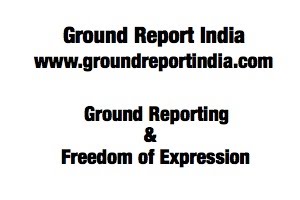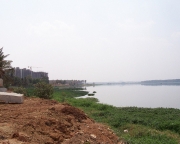Surface Water
An article on Ganga in Ground Report India by Dr. Amarnath Giri
Posted on 03 May, 2010 11:27 AM
Credits to: Ground Report India April-2010-Edition
Hindus have always believed that water from India's Ganges River has extraordinary powers. The Indian emperor Akbar called it the "water of immortality" and always traveled with a supply. The British East India Co. used only Ganges water on its ships during the three-month journey back to England, because it stayed "sweet and fresh."
Indians have always claimed it prevents diseases, but are the claims wives' tales or do they have scientific substance?
Water governance in the Narmada basin - A review paper from the Water Governance Project
Posted on 30 Apr, 2010 06:23 PMThe paper reviews contentious issues related to water governance in the Narmada river basin like the riparian rights of States over apportionment of the use of the waters for large dam-centered canal irrigation and hydro-electric power development and the later disputes around the appropriateness of this model of development given the tremendous environmental and social costs associated with it.
Robust watershed modeling options for participative governance - A Water Governance Project review paper
Posted on 30 Apr, 2010 06:01 PMThis technical review paper puts forward robust watershed modeling options as an instrument of participative governance in the water sector, where there is common agreement among stakeholders on assessment of resource and on the manner in which it is to be utilized. Reasonably validated estimates are developed based on existing data and different scenarios are explored. The models offer a scope of assessing the potential changes in watershed hydrology and water availability due to watershed development projects, and can be used as a basis for planning and monitoring.
"Issues of Water Governance in the Man Basin - Rahul Banerjee" : Water MOVES, Feb 2010
Posted on 28 Apr, 2010 02:30 PMHighlights of the February 2010 issue of "Water MOVES", a quarterly newsletter on Water Governance from the Water Governance Project at Society For Promotion of Wastelands Development (SPWD):
More rain water needed for the east flowing rivers of South India
Posted on 25 Apr, 2010 01:58 PMSIMPLE & EFFECTIVE Method to increase WATER to east flowing RIVERS of SOUTH INDIA.
WESTERN GHATS are the mighty walls created by the nature.
South Asia Rivers should be source of uniting people, not dividing them
Posted on 23 Apr, 2010 03:27 PMGuest Post by Himanshu Thakkar
New Delhi: A workshop organised yesterday on the sidelines of a South Asia civil society gathering under the banner of Assembly of a Union of South Asian Peoples at Jawaharlal Nehru University came up with a set of recommendations to address the question of conflict over shared rivers in the region. The key message from the meeting, which addressed issues pertaining to Pakistan, Bangladesh, Sri Lanka, Bhutan, Nepal and India, was that South Asia’s rivers should be a source of uniting peoples, not dividing them. The Assembly is being organised as a civil society counter to the official SAARC meeting to be held in Thimpu from 28-29 April 2010.
A study on Bellandur tank and changes due to urbanisation - A report by CASUMM
Posted on 21 Apr, 2010 05:08 PM This article by Collaborative for the Advancement of the Study of Urbanism through Mixed Media (CASUMM) presents the case of Bellandur Tank in Bangalore city and highlights how rapid unplanned urbanisation has led to the destruction of one of the biggest water bodies in Bangalore Urban district.
This article by Collaborative for the Advancement of the Study of Urbanism through Mixed Media (CASUMM) presents the case of Bellandur Tank in Bangalore city and highlights how rapid unplanned urbanisation has led to the destruction of one of the biggest water bodies in Bangalore Urban district.
The tank provided sustenance for people who lived in the areas surrounding it and provided water for irrigation, household purposes such as drinking, washing and cleaning, besides providing ample supply of fish. The tank was thus an integral part of the society and had a relationship with the communities residing around the tank.
Local catchment management in cities - A guidebook by UN-HABITAT
Posted on 19 Apr, 2010 05:02 PM This guidebook by UN-HABITAT, provides an overview of the principles and practices required for sustainable urban water catchment management. It deals with the principles and practices for better management of water resources which, in turn, will lead to general improvement in the health of the local population, food security, environmental protection and sustainable development. It states that it is necessary to develop enduring partnerships among the participating institutions and organizations in the catchment area.
This guidebook by UN-HABITAT, provides an overview of the principles and practices required for sustainable urban water catchment management. It deals with the principles and practices for better management of water resources which, in turn, will lead to general improvement in the health of the local population, food security, environmental protection and sustainable development. It states that it is necessary to develop enduring partnerships among the participating institutions and organizations in the catchment area.
Along side, policies, laws and regulations should be geared to provide an enabling framework as needed for formulation and implementation of action plans at the local level. The guidebook also comprises case studies from Australia, India, Latin America and South Africa to showcase the prospects of local action for water resources management.
Sustainable groundwater development through integrated watershed management for food security - A research report by ICRISAT
Posted on 15 Apr, 2010 04:45 PMThis paper by ICRISAT discusses the results from on-farm community watersheds through groundwater management as the drivers for sustainable management of watersheds in dry land areas. The issues of sustainable development and management of the groundwater resource through integrated watershed management (IWM) approach are also dealt with, in the context of food production and security.
State-level utilization of funds and assets created through Ganga Action Plan - Report by Planning Commission for the Supreme Court (2009)
Posted on 15 Apr, 2010 03:41 PMThe report was prepared by the Water Resources Division, Planning Commission in response to a Supreme Court directive to verify whether the funds allocated to Ganga Action Plan (GAP) had been duly utilized by the States. The report is based on data obtained from Central Pollution Control Board (CPCB) and Ministry of Environment and Forests (MoEF) and field visits made to plant sites in Uttarakhand, Bihar and Uttar Pradesh.





